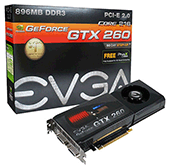Following is the overclocked speeds used, including stock PCI-E BIOS settings. Each clock setting was verified stable using the FurMark Extreme Burning test. 10 MHz higher on any of the 3 clocks began producing artifacts and finally driver failure.
Tests were conducted using the EVGA Precision tool and use the NVidia 196.21 drivers. Note the mention above of driver failure. During the many tests I put this card through, the PC seemed to lock up at times. After about 45 seconds or so, it would come back to life with a notice that the driver failed but had “recovered.” In reality it had not recovered at all. Any test conducted after that point resulted in ruined benchmarks of 17 to 18 fps instead of the 55 to 60 I was expecting. The machine actually required a reboot to return the card/driver to its normal state.
Solid Tip: The driver you use in benchmarks can make a huge difference in results. Additionally, the newest driver will not necessarily yield the best score. The Far Cry 2 benchmark tends to do better with the 196.21 Nvidia driver (which we use here). However, the 197.34 driver does much better in Furmark.
Even during the Extreme Burning test, GPU temps never passed 68°C. This is, of course, with 100% fan power. Either way, it is a testament to the 55nm quality. Notice that your results may vary, but you should easily be able to set your clocks higher than the SSC editions of this card.
Overclocking Limits
| Clock | Starting | OC Limit | Increase |
|---|---|---|---|
| Core | 580 MHz | 740 MHz | 21.6 % |
| Memory | 1998 MHz | 2660 MHz | 24.9 % |
| Shader | 1242 MHz | 1600 MHz | 22.4 % |











